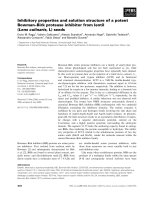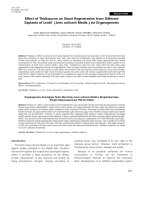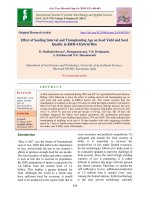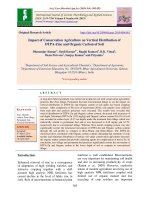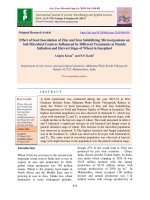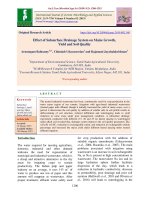Influence of various levels of zinc and sulphur on storage proteins and protein quality of lentil (Lens culinaris) varieties
Bạn đang xem bản rút gọn của tài liệu. Xem và tải ngay bản đầy đủ của tài liệu tại đây (174.96 KB, 6 trang )
Int.J.Curr.Microbiol.App.Sci (2018) 7(6): 3032-3037
International Journal of Current Microbiology and Applied Sciences
ISSN: 2319-7706 Volume 7 Number 06 (2018)
Journal homepage:
Original Research Article
/>
Influence of Various Levels of Zinc and Sulphur on Storage Proteins and
Protein Quality of Lentil (Lens culinaris) Varieties
Ajay Singh Chauhan1 and L. K. Mishra2*
1
2
Department of Biochemistry, College of Agriculture, NDUA&T, Faizabad, U.P., India
Department of Basic Science and Humanities, College of Home Science, Central Agricultural
University, Tura, Meghalaya, India
*Corresponding author
ABSTRACT
Keywords
Albumin, Globulin,
Storage proteins,
Tryptophan
Article Info
Accepted:
22 May 2018
Available Online:
10 June 2018
Influence of varying Sulphur and zinc levels were studied on storage proteins and
protein quality of Lentil (Lens culinaris). Application of 30 kg S/ha enhanced the
soluble proteins, tryptophan, methionine, albumin and globulin. Similarly zinc
application @ 30 kg/ha had positive impact on the soluble proteins (albumin and
globulins) and amino acids (lysine and tryptophan). The positive interaction
between variety, zinc and Sulphur was observed on the tryptophan and albumin
content. Lentil variety K – 75 had the maximum tryptophan and albumin content
on application of 30 kg zinc and Sulphur fertilizers per hectare.
Introduction
India is the largest producer, consumer,
importer and processor of pulses in the world.
Pulses are the basic ingredient in the diets of a
majority of the Indian population, as they
provide a perfect mix of vegetarian protein
component of high biological value when
supplemented with cereals (Ali and Gupta,
2012). Lentil (Lens culinaris Medik.) is one of
the most nutritious cool season food legumes
and ranks next only to chickpea. It is grown
throughout the northern and central India for
grains. Besides its utilisation as a dal, whole or
dehulled grains are also used in various other
preparations. It is one of the prominent
sources of vegetable protein in the IndoGangetic plain (IGP) region, essentially grown
as a rainfed crop on the residual soil moisture
of preceding crop (rice in-general) (Ali et al.,
2012 and Joshi 1998).
Increased popularity of high yielding varieties
(HYV), surging crop intensity, use of
Sulphur/zinc free fertilizers and limited
dependence on organic manures have depleted
soil reserves of these vital plant nutrients
causing emergence of their deficiency in most
of the soils all over India in general and UP in
particular. These nutrients play a vital role in
biosynthesis of proteins and amino acids. The
application of Sulphur and zinc fertilizers has
shown significant effects on yield, uptake of
3032
Int.J.Curr.Microbiol.App.Sci (2018) 7(6): 3032-3037
nutrients and quality parameters in diverse
crops. Research findings supporting the
positive impact of zinc application have been
reported earlier in wheat (Mishra, 2012), rice
(Zeidan et al., 2010; Wei et al., 2012), maize
(Potarzycki et al., 2009), cluster-bean (Meena
et al., 2006), chickpea (Burman et al., 2013).
Likewise, application of Sulphur leading to
improvement in yield and nutritional quality
of cereal (Salvagiotti and Miralles, 2008) has
been extensively reported while studies
elucidating its role on pulses are scarce. Lentil
is one of the principle rabi season crop
cultivated in Indian subcontinent. It serves as
an important source of protein for large
section of population who use pulse as a
principal component in their daily diet. The
protein quality in Lentil has a major drawback
as it is deficient in Sulphur containing
essential amino acids like methionine. In
addition, it also has very low levels of
cysteine.
During seed development in pulses, enormous
quantities of proteins are accumulated over a
short period of time. These accumulated
proteins are of less diversity butconstitute a
major proportion of total seed protein in
mature seeds. The globulin and albumins of
pea, soybean, French bean, chickpea etc. have
been extensively studied both qualitatively
and quantitatively (Roy et al., 2010; Wang et
al., 2008; Boye et al., 2010). But literature on
lentil regarding this aspect of protein quality is
rare. Therefore, keeping this in focus the
present study was carried out.
Materials and Methods
Lentil Samples
varieties were grown using standard
agronomic practices in randomized block
design having three replications. The N, P and
K were applied at the rate of 20:50:40 kg/ha,
respectively. Soil samples were analysed for
Sulphur by turbidity method and zinc by
DTPA extractable method to ascertain their
availability before and after conducting the
experiments.
Chemicals
All chemicals used in the present investigation
were of analytical grade and were purchased
from Qualigen (India), SRL (India), or SigmaAldrich (USA).
Total Protein Content
The total protein content of the lentil seeds
was measured using a modified version of the
Bradford assay (Bradford, 1976). The dye
reagent (Bio-Rad protein assay kit II, Bio-Rad
Laboratory, Hercules, CA) was diluted in 1:4
with distilled water after which 5 mL of the
diluted dye was added to 50 μL of the lentil
seed samples, mixed thoroughly and incubated
in the dark for 5 minutes. For the blank tube
50 μL of distilled water was used instead of
the lentil seed sample. All samples were
analysed in triplicates and the absorbance was
then measured at 595nm using a UV-visible
spectrophotometer (Genesys 10S UV-VIS
spectrophotometer, Thermo Scientific, NY).
A standard curve was prepared using bovine
serum
albumin
(BSA)
in
different
concentrations and the protein content was
expressed as percent dry weight.
Quantitative
Fractions
Four varieties of lentil (Lens culinaris) viz: L
– 4076, K – 75, NDL – 1 and DPL – 15 were
obtained from Student’s Instructional Farm,
NDUA&T, Kumarganj, Faizabad. The
determination
of
Protein
Total protein of raw seed flour was extracted,
based on the method outlined by Basha,
Cherry, & Young (1976). Proteins were
3033
Int.J.Curr.Microbiol.App.Sci (2018) 7(6): 3032-3037
purified by precipitation with 20% TCA and
estimated according to Bradford assay
(Bradford, 1976). The albumin and globulin
fractions were separated, based on Murray
(1979).
The protein fractions obtained were
precipitated with TCA and re-dissolved in 0.2
N NaOH and protein content was determined
according to Bradford assay (Bradford, 1976)
and expressed as g/100g protein.
Determination of Amino acid composition
Methionine content was determined according
to the method of Horn et al., (1946). Lysine
was determined according to the method of
Felker et al., (1978) and the method proposed
by Spies and Chamber (1949) was used to
determine the tryptophan content. The results
for amino acids were reported as and
expressed as g/100g protein.
Statistical analysis
Entire biochemical analysis was repeated two
times. Two runs were performed from each
extraction and all assays were carried out in
triplicates (n = 12). Means, standard errors,
and standard deviations were calculated from
replicates using MS-Excel. The data were also
analyzed for analysis of variance (ANOVA)
using Statistical Analytical Software (SAS
version 9.4; SAS Institute, Cary, NC).
Results and Discussion
The content of protein, tryptophan, lysine,
methionine, globulin and albumin increased
significantly with increasing levels of Sulphur
upto 30kg/ha (Table 1). The increasing trend
in the protein fractions may be attributed to
the fact that Sulphur stimulates the
biosynthesis of proteins and Sulphur
containing amino acids which is reflected
during the assay of the samples. Similar trend
was observed for tryptophan and lysine also.
Sulphur being an essential structural
component of amino acids, co-enzymes
involved in protein synthesis may have led to
the increasing trend in protein and amino acids
visible in the present investigation. Similar
findings have been reported by Mishra et al.,
(2012), Raikwar et al., (2012) in wheat and
barley respectively. Jamal et al., (2005)
reported comparable results in soybean and
Chiaiese et al., (2004) in chickpea.
Albumin content also increased significantly
with increasing levels of Sulphur up to
30Kg/Ha. This may be due to high amino acid
content particularly Sulphur containing amino
acid methionine which is an important
constituent of albumin protein fraction. On the
contrary globulin fraction did not show any
increase. The results are in accordance to the
findings of Sharma and Sharma (2014);
Sharma et al., (2013).
There was significant increase in all the
parameters except protein, albumin and
globulin content (table 1). Application of zinc
significantly increased tryptophan content.
Tryptophan is an essential amino acid
containing aromatic ring and zinc in directly
involved in the synthesis of this amino acid.
Tryptophan is a precursor of auxin hormone
and is therefore important in normal growth of
the plants also.
The role of zinc as cofactors of several
enzymes is well established. Similar findings
were observed by Mishra (2012) in wheat,
Wang &Daun (2004) in Pisum sativum and
Togay et al., (2004) in Phaseolus vulgaris L.
A significant increase in lysine content was
also observed by increasing zinc doses at
30Kg/ha, which in turn results in increased
globulin content. Findings of Togay et al.,
(2004) in Phaseolus vulgaris L. support the
results obtained in this investigation.
3034
Int.J.Curr.Microbiol.App.Sci (2018) 7(6): 3032-3037
Table.1 Biochemical composition of lentil as influenced by varieties, sulphur and zinc levels
Treatment
Protein
(% DW)
Tryptophan
(g/100g
protein)
Variety
DPL – 15 24.79
0.63
NDL -1
24.94
0.96
K – 75
26.16
0.99
L – 4076
24.48
0.60
CD at 5 % 0.51
0.02
Sulphur levels (in Kg/ha)
Control
24.71
0.77
10
25.05
0.80
20
25.16
0.81
30
25.45
0.82
CD at 5 % 0.51
0.01
Zinc levels (Kg/ha)
Control
25.02
0.75
10
25.04
0.81
20
25.23
0.82
30
25.08
0.81
CD at 5 % 0.51
0.02
Lysine
(g/100g
protein)
Methionine
(g/100g
protein)
Albumin
(g/100g
protein)
Globulin
(g/100g
protein)
1.97
1.98
1.97
1.93
0.04
0.48
0.48
0.54
0.48
0.01
8.36
9.00
9.34
8.12
0.17
59.20
60.04
60.06
59.45
1.28
1.87
1.97
2.01
2.02
0.04
0.48
0.49
0.50
0.51
0.01
8.57
8.65
8.77
8.83
0.16
57.95
59.70
60.26
60.84
1.27
1.89
1.96
1.21
1.99
0.03
0.49
0.49
0.50
0.48
0.01
8.65
8.71
8.76
8.70
0.17
57.89
60.30
60.76
59.80
1.28
Table.2 Interaction of variety and sulphur on tryptophan (g/100g protein) in lentil varieties
Zinc levels (Kg/ha)
Control
10
20
30
CD at 5 %
DPL – 15
0.63
0.53
0.63
0.63
K – 75
1.05
1.01
1.08
1.11
0.03
NDL -1
0.65
0.65
0.65
0.62
L – 4076
0.63
1.01
0.89
0.97
Table.3 Interaction of variety and sulphur on albumin (g/100g protein) in lentil varieties
Sulphur levels (Kg/ha) DPL – 15
Control
8.09
10
8.29
20
8.09
30
8.96
CD at 5 %
K – 75
9.33
9.32
9.45
9.26
0.03
NDL -1
8.78
9.01
9.44
8.78
The variety K – 75 proved significantly
superior to rest of the three varieties (DPL –
15, NDL – 1, L – 4076) with respect to all the
L – 4076
8.10
7.96
8.10
8.33
protein quality parameters and storage
proteins (Table – 1). The varietal difference
among the three samples studied may be
3035
Int.J.Curr.Microbiol.App.Sci (2018) 7(6): 3032-3037
attributed to difference in genetic constitution.
The results are in concordance to the findings
reported by Mishra (2012), Wang and Daun
(2004).
The interactive effect of zinc and varieties
was significant and it was maximum in the
variety K – 75 followed by NDL – 1 with 30,
40 and 20 Kg Zn/ha (table 2). Similar
observations were also reported by Dwivedi
et al., (2002).
The combined response of different levels of
Sulphur and varieties were also noticed in
albumin content (Table 3). The variety K – 75
performed better with 20 Kg S/ha. Our results
are in accordance with the findings of Wang
and Daun (2004).
The findings of the investigation indicate that
lentil is a reasonable source of protein with
the variety K – 75 having the highest protein
content. It is also concluded that application
of sulphur and zinc fertilizers at 30Kg/ha was
the best dose that led to maximum protein
content, albumin and globulin fractions. The
application of zinc and sulphur fertilizer also
led to increase in essential amino acids lysine,
tryptophan and methionine reasonably well in
all the varieties investigated. Overall it may
be concluded that zinc and sulphur
application @ 30Kg/ha can be used to
improve both quantity and quality of varieties
of lentil.
Acknowledgement
The university scholarship received by the
first author is greatly acknowledged.
References
Ali, M., & Gupta, S. (2012). Carrying capacity
of Indian agriculture: pulse crops. Current
Science, 874-881.
Ali, R.I., Awan, T. H., Ahmad, M. M., Saleem,
U and Akhtar, M. (2012). Diversification of
rice-based cropping systems to improve
soil fertility, sustainable productivity and
economics. Journal of Animal and Plant
Sciences 22(1): 108–12.
Boye, J., Zare, F., & Pletch, A. (2010). Pulse
proteins: Processing, characterization,
functional properties and applications in
food
and
feed. Food
research
international, 43(2), 414-431.
Bradford, M.M., 1976. A rapid and sensitive
method for the quantitation of microgram
quantities of protein utilizing the principle
of
protein-dye
binding.
Analytical
Biochemistry 72: 248–254.
Burman, U., Saini, M., & Kumar, P. (2013).
Effect of zinc oxide nanoparticles on
growth and antioxidant system of chickpea
seedlings. Toxicological & Environmental
Chemistry, 95(4), 605-612.
Chiaiese, P., Ohkama-Ohtsu, N., Molvig, L.,
Godfree, R., Dove, H., Hocart, C., and
Tabe, L. M. (2004). Sulphur and nitrogen
nutrition influence the response of chickpea
seeds to an added, transgenic sink for
organic sulphur. Journal of Experimental
Botany, 55(404), 1889-1901.
Dwivedi. S. R., Singh, R.B. and Dwivedi, K.N.
(2002). Effect of Sulphur and zinc nutrition
on yield and quality of maize in typic
ustrochrept soil of Kanpur. J. of Ind. Soc. of
Soil Sci., 50 (1): 70-74.
Felker, C., Libanauskas, C. K., and Wainer, G.
(1978).
Estimation
of
lysine
in
foods. Crops Sci, 18(3), 480-490.
Horn, M. J., Jones, D. B., & Blum, A. E.
(1946). Colorimetric determination of
methionine in proteins and foods. J. Biol.
Chem, 166, 313-320.
Jamal, A., Fazli, I. S., Ahmad, S., Abdin, M. Z.,
& Yun, S. J. (2005). Effect of sulphur and
nitrogen
application
on
growth
characteristics, seed and oil yields of
soybean cultivars. Korean Journal of Crop
Science, 50(5), 340.
Joshi, P. K. (1998). Performance of grain
legumes in the Indo-Gangetic Plain in
residual effects of legumes in rice and
wheat cropping systems of the IndoGangetic Plain. (In) Legumes in Rice and
3036
Int.J.Curr.Microbiol.App.Sci (2018) 7(6): 3032-3037
Wheat Cropping Systems of the IndoGangetic Plain. Kumarrao, J. V. D. K.,
Johansen, C. and Rego, T. J. (Eds).
ICRISAT, Patancheru, Andhra Pradesh, pp
3–13.
Kumar, A., Sharma, S., Sital, J. S., & Singh, S.
(2013). Effect of Sulfur and Nitrogen
Nutrition on Storage Protein Quality in
Mungbean [Vigna radiata (L.) Wilczek]
Seeds. Indian Journal of Agricultural
Biochemistry, 26(1), 86-91.
Meena, K. R., Dahama, A. K., & Reager, M. L.
(2006). Effect of Phosphorus and Zinc
Fertilization on Growth and Quality of
Clusterbean [Cyamopsis tetragonoloba (L.)
Taub.]. Annals
of
Agricultural
Research, 27(3).
Mishra, L. K. (2012). Effect of phosphorus and
zinc
fertilization
on
biochemical
composition of wheat. The Bioscan, 7(3),
445-449.
Potarzycki, J., & Grzebisz, W. (2009). Effect of
zinc foliar application on grain yield of
maize and its yielding components. Plant
Soil Environ, 55(12), 519-527.
Raikwar, R.S, and MIshra, L.K. (2012). Genetic
architecture of yield and quality traits under
problematic soils in Barley (Hordeum
vulgare L.). International Journal of
Agriculture,
Environment
and
Biotechnology, 5:1, 13-17.
Roy, F., Boye, J. I., & Simpson, B. K. (2010).
Bioactive proteins and peptides in pulse
crops: Pea, chickpea and lentil. Food
research international, 43(2), 432-442.
Salvagiotti, F., & Miralles, D. J. (2008).
Radiation interception, biomass production
and grain yield as affected by the
interaction of nitrogen and sulfur
fertilization in wheat. European Journal of
Agronomy, 28(3), 282-290.
Sharma, A., & Sharma, S. (2014). Effect of
nitrogen and sulphur nutrition on yield
parameters and protein composition in
soybean
[Glycine
max
(L.)
Merrill]. Journal of Applied and Natural
Science, 6(2), 402-408.
Spies, J. R., & Chambers, D. C. (1949).
Chemical determination of tryptophan in
proteins. Analytical
Chemistry, 21(10),
1249-1266.
Togay, N., Ciftci, V., & Togay, Y. (2004). The
effects of zinc fertilization on yield and
some yield components of dry bean
(Phaseolus vulgaris L.). Asian Journal of
Plant Sciences, 3(6), 701-704.
Wang, N., & Daun, J. K. (2004). Effect of
variety and crude protein content on
nutrients and certain antinutrients in field
peas (Pisum sativum). Journal of the
Science of Food and Agriculture, 84(9),
1021-1029.
Wang, Z. H., Li, S. X., & Malhi, S. (2008).
Effects of fertilization and other agronomic
measures on nutritional quality of
crops. Journal of the Science of Food and
Agriculture, 88(1), 7-23.
Wei, Y., Shohag, M. J. I., & Yang, X. (2012).
Biofortification and bioavailability of rice
grain zinc as affected by different forms of
foliar zinc fertilization. PloS one, 7(9),
e45428.
Zeidan, M. S., Mohamed, M. F., & Hamouda,
H. A. (2010). Effect of foliar fertilization of
Fe, Mn and Zn on wheat yield and quality
in low sandy soils fertility. World J. Agric.
Sci, 6(6), 696-699.
How to cite this article:
Ajay Singh Chauhan and Mishra L. K. 2018. Influence of Various Levels of Zinc and Sulphur
on Storage Proteins and Protein Quality of Lentil (Lens culinaris) Varieties.
Int.J.Curr.Microbiol.App.Sci. 7(06): 3032-3037. doi: />
3037

